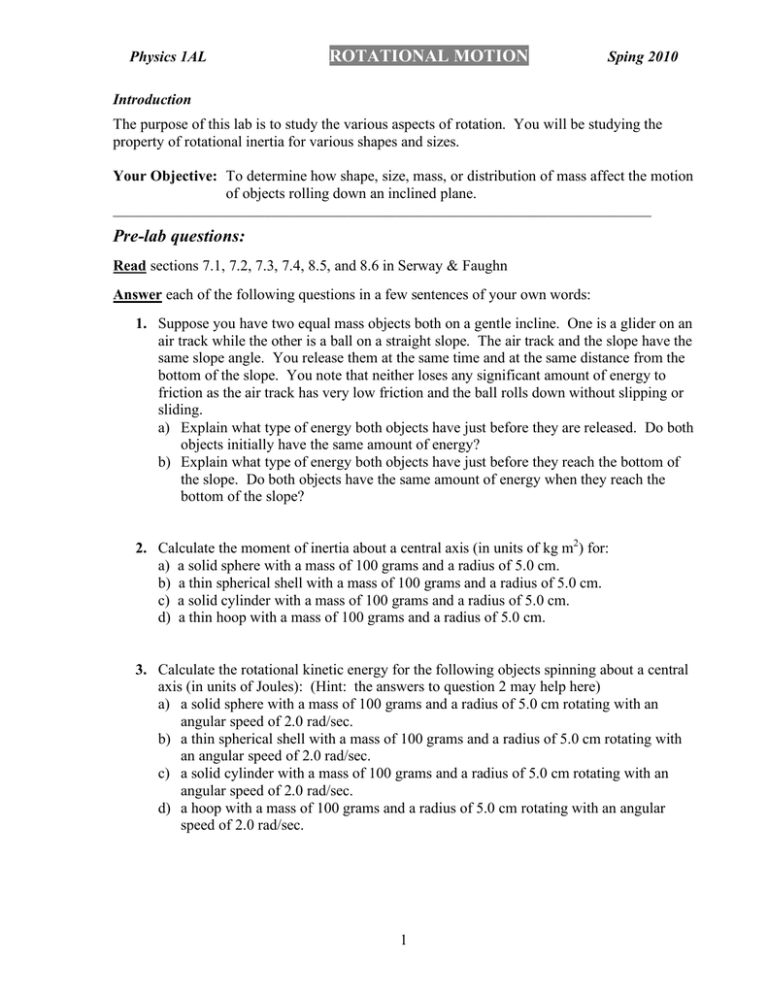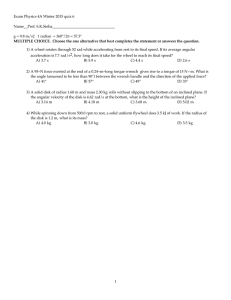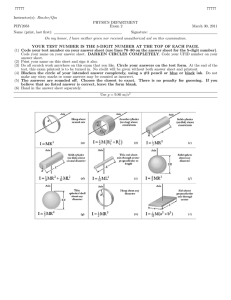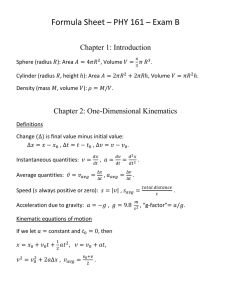ROTATIONAL MOTION
advertisement

Physics 1AL ROTATIONAL MOTION Sping 2010 Introduction The purpose of this lab is to study the various aspects of rotation. You will be studying the property of rotational inertia for various shapes and sizes. Your Objective: To determine how shape, size, mass, or distribution of mass affect the motion of objects rolling down an inclined plane. ______________________________________________________________________________ Pre-lab questions: Read sections 7.1, 7.2, 7.3, 7.4, 8.5, and 8.6 in Serway & Faughn Answer each of the following questions in a few sentences of your own words: 1. Suppose you have two equal mass objects both on a gentle incline. One is a glider on an air track while the other is a ball on a straight slope. The air track and the slope have the same slope angle. You release them at the same time and at the same distance from the bottom of the slope. You note that neither loses any significant amount of energy to friction as the air track has very low friction and the ball rolls down without slipping or sliding. a) Explain what type of energy both objects have just before they are released. Do both objects initially have the same amount of energy? b) Explain what type of energy both objects have just before they reach the bottom of the slope. Do both objects have the same amount of energy when they reach the bottom of the slope? 2. Calculate the moment of inertia about a central axis (in units of kg m2) for: a) a solid sphere with a mass of 100 grams and a radius of 5.0 cm. b) a thin spherical shell with a mass of 100 grams and a radius of 5.0 cm. c) a solid cylinder with a mass of 100 grams and a radius of 5.0 cm. d) a thin hoop with a mass of 100 grams and a radius of 5.0 cm. 3. Calculate the rotational kinetic energy for the following objects spinning about a central axis (in units of Joules): (Hint: the answers to question 2 may help here) a) a solid sphere with a mass of 100 grams and a radius of 5.0 cm rotating with an angular speed of 2.0 rad/sec. b) a thin spherical shell with a mass of 100 grams and a radius of 5.0 cm rotating with an angular speed of 2.0 rad/sec. c) a solid cylinder with a mass of 100 grams and a radius of 5.0 cm rotating with an angular speed of 2.0 rad/sec. d) a hoop with a mass of 100 grams and a radius of 5.0 cm rotating with an angular speed of 2.0 rad/sec. 1 Physics 1AL ROTATIONAL MOTION Sping 2010 LAB WORK A. Angular Acceleration of a Rotating Disk Introduction: This experiment uses a disk rotating about a vertical axis through the center of the disk. A string is tied to a pulley which is attached to the disk. The disk experiences a torque, τ, provided by a hanging mass which is attached to the other end of the string as shown in the figure to the right. You will be examining the angular acceleration of two shapes: a solid disk and a thick hollow ring. We will be focusing on the hanging mass for the measured values of this experiment. The hanging mass would fall at a rate of 9.8 m/s2 except that it has a tension force due to the string that is slowing it down. Our goal is to find the acceleration value of the hanging mass, ay, by measuring the time it takes for the mass to fall a given value, Δy. The distance that the hanging mass (which is initially at rest) will fall is given by the following equation: 1 "y = at 2 2 There are two forces causing this acceleration: the force due to gravity on the hanging mass and the tension force due to the string. From the measured acceleration value and by calculating the force due to gravity, you will calculate the tension force due to the string on the hanging mass. ! The tension force is also creating torque on the rotating disk which is causing an angular acceleration. We can calculate the torque due to the tension force from the following equation: (Στ = rF), where r is the radius value is the distance from the central axis of the rotating disk to the place where the string attaches. We can then calculate the angular acceleration of the disk from the following equation: (Στ = Iα), where I is the moment of inertia of the rotating disk. The value for angular acceleration, α, is our final goal. A1. Start by measuring the distance that the mass will drop when you are conducting the experiment. The mass will start at some initial value and drop to a final value due to the length of the string. This measured value will be your Δy distance for your equation. A2. Make sure the string passes over the pulley and attaches to the solid disk. If you want, you may ask your TA if the setup is accurate. A3. Now perform the experiment by taking the mass up to its initial value and releasing it. Measure the time it takes for the mass to fall the distance Δy with a stopwatch. Repeat the experiment five times is order to get an accurate time value. A4. Record all five time values in your notebook. Take the average value for time to calculate the acceleration of the hanging mass. A5. Draw a force diagram for the hanging mass. From this diagram write an equation based on Newton’s 2nd Law (ΣF = ma) to find the tension force due to the string on the 2 Physics 1AL ROTATIONAL MOTION Sping 2010 hanging mass. (Hint: you can easily calculate the value for the force due to gravity on the hanging mass.) A6. From the value of acceleration found in A4 and the equation you derived in A5, calculate the tension force due to the string on the hanging mass. A7. Measure the distance from the central axis to the location of the string that is wrapped around the rotating disk. This is the radius value that is providing the torque that is making the disk rotate. A8. Calculate the magnitude of torque on the disk from the tension force you calculated in A6 and from the radius value you measured in A7. A9. Calculate the moment of inertia of the rotating disk (refer to pre-lab question 2 for all of the parameters you will need to find for each object). A10. Finally, calculate the angular acceleration, α, value for the rotating disk from the moment of inertia you calculate in A9 and the torque value you calculated in A8. A11. Repeat steps A1 to A10 for the thick hollow ring. Your final goal is the angular acceleration value for the hollow ring. (Note: the moment of inertia of a thick hollow 1 m R 2 + R22 ) ring is: 2 ( 1 , where m is the mass of thick hollow ring, R1 is the inner radius of the thick hollow ring, and R2 is the outer radius of the thick hollow ring.) A12. Which shape had the greatest value for angular acceleration? Which shape had the ! greatest moment of inertia? B. Shape Races In this experiment, you will take a variety of objects and try to race them down a straight slope For each race make sure you release the objects at the same height and at the same time (a ruler usually accomplishes this task well enough). There are five objects that you will be racing: a solid sphere, a hollow ring, a large radius solid aluminum disk, a small radius solid aluminum disk, and a small radius solid copper disk. Make sure you have all five objects. Race the objects in pairs. B1. Before you conduct any of the races, you need to make predictions for the various shapes. Discuss as a group which shapes would win for the following object races: 1) A large radius solid aluminum disk vs. a hollow ring. 2) A large radius solid aluminum disk vs. a solid sphere. 3) A solid sphere vs. a hollow ring. 4) A solid sphere vs. a small radius solid aluminum disk. 5) A small radius solid aluminum disk vs. a hollow ring. 6) A large radius solid aluminum disk vs. a small radius solid aluminum disk. 7) A large radius solid aluminum disk vs. a small radius solid copper disk. 3 Physics 1AL ROTATIONAL MOTION Sping 2010 B2. After you have made your predictions, write them down in your notebook and discuss them with your TA. B3. Conduct the races between the shapes that you predicted in B1. Write down the results of the actual races in your notebook. Make sure you race each pair at least five times so that the results are obvious. B4. Which shape in your collection is the overall fastest? Which shape in your collection is the overall slowest? B5. Measure the mass and radius of each shape. B6. Calculate the moment of inertia of each object in the race (refer to pre-lab question 2 for all of the parameters you will need to find for each object). B7. Which shape in your collection has the greatest moment of inertia? Which shape in your collection has the least moment of inertia? Conclusion: 1. Your TA will inform you which section of this lab you should write up for a conclusion. 4





